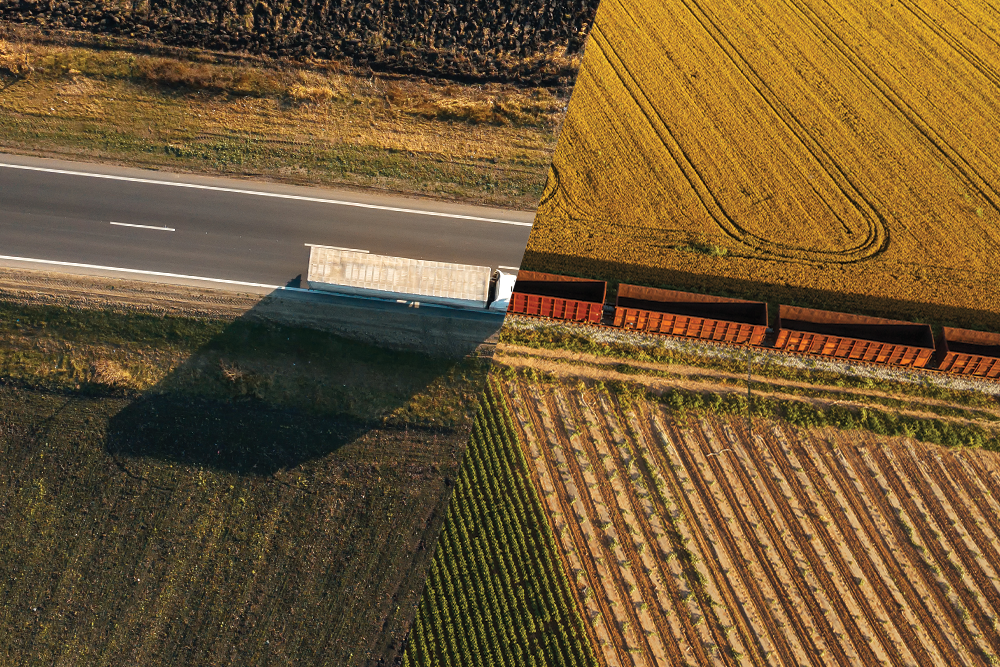Truck vs. Rail: What’s the Best Way to Ship Granular Fertilizer?

At Keg River Chemical, we manufacture degradable sulfur fertilizer. Elemental sulfur is combined with bentonite clay and formed into hard pastilles. Like most granular fertilizers, it is well suited to ship in bulk or in totes.
Our customers are North American line retailers and buying groups representing individual retailers and small chains.
They often ask, “Which shipping method is most advantageous?”
The short answer is, “It all depends on your situation.” There are a several factors at play. In this post, we’ll do a side-by-side comparison of both methods and discuss the pros and cons of each.
Shipping costs based on distance
Shipping by Truck: Shipping by truck is generally more cost-effective for shorter distances. The cost includes not just the fuel but also the labor, as you pay for the drivers’ time. Trucks can also go directly to the destination, saving handling costs and transfer time.
Shipping By Rail: Rail is typically more economical for long-distance shipments. Although the final delivery from the terminal might require trucking, the bulk of the distance is covered by rail, which has lower fuel costs per ton-mile than road transport. This can lead to significant savings, particularly for large shipments.
Keg River’s manufacturing plant is in Edmonton, Alberta, Canada. We ship our products great distances. With today’s high cost of diesel, we are increasingly finding shipment by rail is more economical for many of our clients.
Speed of delivery
Truck: Trucks offer faster delivery times, especially for ‘door-to-door’ service. Since trucks can take more direct routes (vs. rail lines), they can often deliver goods more quickly, assuming there are no significant traffic delays. There are, hoewer, limits on how many hours a trucker can drive before taking a mandatory rest. (See Federal Motor Carrier Safety Administration guidelines for cross-border drivers.)
Rail: Rail transport can be slightly slower due to the logistics involved in rail scheduling and the time it takes to load and unload railcars. However, long-haul trains can move continuously day and night and are not generally affected by traffic, which can make up for some time lost during loading and transfers.
For the most part, at the retail level, elemental sulfur fertilizer is ordered in advance with plenty of lead time built in – making rail a viable option. That said, in some instances where orders are placed later, trucking may be the best option.
Shipping capacity/order volumes
Truck: Trucks have limited capacity compared to trains. Trucks are permitted to carry payloads between 22-25 tons across most US states. In the Pacific Northwest that jumps to 30-35 tons. In Canada, loads up to 44 metric tons are allowed. A large shipment may require multiple trucks.
Rail: Trains excel in carrying capacity. A single railcar can carry two to four times more fertilizer vs. OTR (over-the-road). The average railcar can hold 96 tons (88 metric tons) of pastilles.
A single railcar can carry 2 to 4X more fertilizer vs. OTR.
As a buyer, several factors will determine your order volumes for degradable sulfur fertilizer:
- The type of crops grown in your territory
- The type of soil in your territory (eg. sandy soils, high pH soils)
- The number of outlets being supplied
- Application timing
Shipping reliability
Truck: Trucking can be subject to delays from traffic, weather conditions, border delays and road repairs. However, the ability to take another route can sometimes mitigate these issues.
Rail: Rail tends to be more reliable in terms of scheduling. Trains follow set timetables and are less likely to be delayed by traffic. However, they can be impacted by track maintenance and other logistical challenges. Once on the move, trains are less prone to delays than trucks. Additionally, railcars can be tracked along the route so you can monitor progress.
At Keg River, we find reliability is not typically a factor either way. We work with a trusted team of long-haul truckers and have long-term relationships with our drivers. We own a fleet of 15 rail cars, which has grown to keep up with customer demand.
Truck vs. rail: Environmental impact
Truck: Trucks generally have a higher carbon footprint per ton-mile than trains and contribute more to greenhouse gas emissions.
Rail: Trains emit fewer greenhouse gases per ton-mile and are more fuel-efficient, which means they have a lower impact on climate change per unit of freight transported.
As larger retailers adopt ESG strategies, shipping by rail can support company-wide efforts to minimize their environmental impact.
Shipping fertilizer by truck or rail: what makes sense for you?
The decision between truck and rail for shipping granular fertilizer in North America depends on the specific needs of your shipment. To summarize:
Ship by truck if you’re:
- Transporting goods over shorter distances
- You’re on a tight delivery timeline
- You’re ordering smaller fertilizer volumes
- Your destination does not have easy rail access.
Consider rail if you’re:
- Ordering large volumes of fertilizer
- Shipping medium or long distance
- Located on a rail siding
- Seeking a cost-effective solution for bulk shipments
- Want to reduce your environmental footprint
Of course, many customers who receive by rail still require trucks to take their shipment the ‘final mile’ to their fertilizer plants.
By considering all these factors, you can choose the most efficient and sustainable method for shipping granular fertilizer, ensuring that your fertilizer arrives on time and within budget that supports your bottom line.




